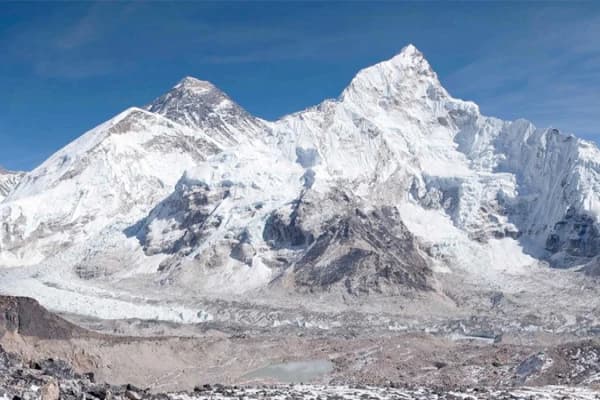Mount Everest, which stands at the borders of Tibet and Nepal, reaches a height of 8,848 meters (29,029 feet) above sea level. It boasts breathtaking natural beauty, intense cultural life, and outstanding mountaineering feats.
Most people still have one common question: Where is Mount Everest located? Is it in Nepal or China? This blog will guide you on its location, geographical significance, and why it is the tallest peak in the world.
What Country is Mount Everest in?

Mt Everest is situated on the border between Nepal and Tibet, a self-governing region in China. The mountain sits on two nations: its southern part is in Nepal, while its northern part is in Tibet. Mount Everest lies in the Mahalangur section of the Himalayas, the great mountain range that spans five countries: India, Bhutan, Nepal, China, and Pakistan.
Where is Mount Everest Located? - Is it in Nepal or China?
Mount Everest is located in Nepal and shares its border with China(Tibet). Its northern side is in Tibet, China, whereas its southern flank is in Nepal. Due to that fact, Mount Everest is regarded as a common natural heritage, viewed from two perspectives: Nepal's and Tibet's. In that way, Mount Everest will serve as a significant natural wonder that keeps two major areas of the continent connected, utilizing respect for and trust in one another.
The summit of Mount Everest, standing at 8,848.86 meters (29,031.7 feet), attracts climbers from Nepal and Tibet. The southern route from Nepal is more popular and commonly used because it’s less technically challenging than the northern route from Tibet.
What is the Geography of Mount Everest?
Mount Everest, perched on the crest of the great Himalayan range in southern Asia, straddles the border between Nepal and the Tibet Regionof China. Its extreme altitude and unique position make this iconic peak a geographical wonder of immense significance.
Where is Mount Everest located geographically? The answer lies in its precise coordinates: 27°59′N 86°56′E, pinpointing its exact position on the map. These coordinates are essential for understanding the mountain's actual position on the map and for planning trips to the hill. The Everest Base Camp altitude, located at approximately 5,364 meters (17,598 feet) on the mountain's south side, is a starting point for climbers attempting to reach the summit.
Recommended Read: How Cold is Mount Everest?
What are the different names of Mount Everest?
The different names of Mount Everest are Sagarmatha, Chomolungma Qomolangma, and Peak XV.
Sagarmatha - Nepali Perspective
It is the Nepali name that means 'Forehead in the Sky.' It reflects Everest's spiritual significance for the Sherpa people and the larger Nepali community as a connection between the earth, the sky, and a deity.
Chomolungma - The Tibetan View
The Tibetan name for Mount Everest is Chomolungma, which means "Mother Goddess of the World." For the Tibetans, Chomolungma is the spiritual essence of the Himalayas, reflecting their deep reverence for the mountain. It embodies all the qualities a mother's love, strength, and nurturing imply.
Mount Everest- The English Legacy
Mount Everest's name was given in English as a tribute to Sir George Everest, the British surveyor general of India. According to Western standards, it is now accepted as the highest mountain in the world.
Peak XV
Mount Everest was initially named "Peak XV" in the 19th-century Great Survey of India. Since no generally accepted local name was known to the British then, they used a numerical designation. In 1865, Mount Everest officially got its name after Sir George Everest, the then-serving surveyor general of India.
Different Climbing Routes on Mount Everest
Climbers face many obstacles and challenges when attempting to reach the top of Mount Everest, and each route has its unique rewards and challenges. Two main routes for climbing Mount Everest are the North Col Route, which is reachable from Tibet, and the South Col Route, which is reachable from Nepal.
South Col Route
The South Col. route from Nepal is the most popular and commonly used path to reach the summit of Mount Everest. Climbers begin in Nepal, crossing the Khumbu Icefall, navigating the Western Cwm, and scaling the Lhotse Face before arriving at the South Col. A walk through the Khumbu region is not only stunningly beautiful but also offers a deep dive into Sherpa culture. The South Col route is technically easier and enjoys better infrastructure and support services, which many climbers prefer. The final climb from the South Col goes up the southeast ridge to the summit. This route is favoured due to the iconic Base Camp in Nepalese.
North Col Route
Starting from Tibet, The North Col route offers different challenges and rewards for climbers aiming to summit Mount Everest. The North Col route leads climbers up the North Ridge, with steeper and more exposed terrain, harsher weather, and strong winds. The route is considered more technically challenging than the South Col route and is less crowded. Because of its difficulty, fewer climbers use it, making it an option for those seeking a more formidable challenge on Mount Everest. Some climbers choose this route for its unique challenges and the opportunity to climb from the less-crowded northern side, though getting permits in Tibet is more complicated.
Explore Our Everest Base Camp Packages - Ultimate Himalayan Adventure

We have popular EBC trekking packages that allow you to view stunning Mount Everest in Nepal. These packages are designed to offer breathtaking views of Mount Everest from the southern side of Nepal. Real Adventure offers an excellent holiday package for Everest Base Camp, providing top-notch service, a customized itinerary, and a great trekking experience throughout the journey.
Everest Base Camp Trek- 14 Days
It starts with a 14-day Everest Base Camp Trek, filled with awe-inspiring sights of towering mountains and rich Sherpa culture. Your journey begins with a short flight from Kathmandu to Lukla, a charming Sherpa town amidst the hills. During the scenic flight, you'll be treated to magnificent views of the Himalayas.
The Everest View Luxury Lodge Trek - 8 Days
The Everest View Luxury Lodge Trek is a short and easy trek to the Hotel Everest View, which sits high up in the mountains of northeastern Nepal. During these eight days, you'll see amazing sights such as Mount Everest, the tallest mountain on Earth, and many other stunning Himalayan peaks. Immerse yourself in the traditions and culture of the Sherpa people by visiting their villages and monasteries. Experience the chance to spot some rare animals in Sagarmatha National Park.
Everest Base Camp Trek with Island Peak Climb - 19 Days
19-day Everest Base Camp trek with Island Peak climb is an unforgettable adventure that promises stunning scenery, cultural immersion, and the thrill of conquering a Himalayan summit. This epic journey begins in Kathmandu, Nepal's vibrant capital, where trekkers soak in the rich culture before flying to Lukla, the gateway to the Everest region.
Everest Three High Passes Trek - 22 Days
The Everest Three High Passes Trek is one of the most thrilling and adventurous journeys you can take in the Everest region of Nepal. It crosses three big mountain passes in the Khumbu area: Renjo La, Cho La, and Kongma La. Along the way, you'll be treated to incredible views of some of the world's highest peaks, like Mt. Everest, Mt. Ama Dablam, Mt. Lhotse, Mt. Cho Oyu, and Mt. Makalu.
Everest Base Camp Trek with Helicopter Return - 9 Days
9 Days Shortest Everest Base Camp Trek offers a unique opportunity to trek to Everest Base Camp and return to Kathmandu, combining ground and air adventures for an unforgettable journey through the stunning Khumbu landscape.
Short Everest Trek with Helicopter Return via EBC- 3 Days
The 3-day Everest Base Camp Trek with Helicopter Return begins with a flight from Kathmandu to Lukla. It combines trekking with a helicopter ride, saving time and energy while offering breathtaking views. The highlight of the trek is the helicopter ride to Everest Base Camp.
Everest Base Camp Trek with Cho La Pass and Gokyo Ri
This 19-day trek witnesses the crown jewel of the Himalayas: Mount Everest. It combines the classic Everest Base Camp route with a thrilling detour through the Cho La Pass and the serene Gokyo Lakes.
Everest View Luxury Lodge Trek - Return by Helicopter - 5 Days
The 5-day Everest View Luxury Lodge Trek offers an unforgettable journey through the majestic Everest region of Nepal. It combines breathtaking mountain vistas, cultural immersion, and luxurious accommodations. Throughout the trek, you’ll experience stunning views of Mount Everest, the highest peak on Earth, and other majestic mountains such as Lhotse, Nuptse, and Ama Dablam.
Countries Near Mount Everest
Mount Everest is spread over several countries, including Nepal, China, India, Bhutan, and Pakistan.
Nepal: Mount Everest lies in the southern part of Nepal. Trekkers and mountaineers worldwide trek to Everest Base Camp on the Nepalese side, offering breathtaking views and a challenging climb through the Khumbu region.
China-Tibet: The northern face of Mount Everest lies in Tibet, a self-governing region of China. Tibet is known for its distinctive cultural heritage, deeply rooted in Tibetan Buddhism. Visitors find their way to the Tibetan base camp not only for an alternative view of Mount Everest but also to plunge into the serene, unspoiled beauty of the Tibetan Plateau.
India: Nepal shares a border with India to the south. Although Mount Everest is not on the Indian border, India has deep historical and cultural connections with the Himalayas. The eastern Himalayas can be accessed through the West Bengal and Sikkim states. Each has a stunning number of peaks and hiking paths.
Bhutan: Bhutan is located southeast of Nepal. It primarily lies on the border between Nepal and China's Tibet Autonomous Region.
Pakistan: Pakistan borders China in the west. Although Pakistan does not host Mount Everest, it is a vital gateway for mountain climbers and trekkers because it is near the extended Himalayas and many of its high peaks.
The Best Places to View Mount Everest
The best viewpoint from which one can view Mt. Everest is at the Base Camp of Everest in Nepal, right at the base of the southern side of Everest. It is the closest you can get to the mountain without actually climbing it. One can view the striking scenery of Everest with its majestic face, which cannot fail to incite one's awe and wonder.
Kala Patthar, Nepal, is one of the most critical viewpoints around Everest Base Camp. The views of Everest are iconic and will excite and inspire any mountaineer. At 5,545 meters above sea level, Kala Patthar offers breathtaking views of the mountain and other peaks that surround it, especially at sunrise when the rising sun shades Everest with a golden hue.
Recommended Read: Best Treks in Everest Region
When is the Best Time to visit Mount Everest?

The best times for an Everest Base Camp trek are from March to May or mid-September to November.
Spring (March to May):
Spring is an excellent time to trek to Everest Base Camp due to the mild temperature and clear skies, offering the chance to appreciate the stunning scenery fully. This season also brings blooming rhododendrons and other vibrant flowers, enhancing the trek's natural beauty. The trail tends to be busier, with more trekkers contributing to a lively and energetic atmosphere.
Autumn (September to November):
During autumn (September to November), the weather is generally stable and precise, providing excellent visibility and stunning views of the mountains. This season is particularly favoured for its moderate temperatures and favourable trekking conditions.
However, because it is a popular time for trekkers, you may encounter crowded trails and busy teahouses. You should be prepared for potential changes in temperature, including occasional rain or even snowfall at higher altitudes. Nights can be pretty cold, requiring proper gear and warm clothing.
Recommended Read: Why is Everest Base Camp so Popular?
Is Climbing Mount Everest from China or Nepal Easier?
The problem in trekking to the summit from either China or Nepal involves mountainous terrain and highly variable weather conditions. Most would agree that climbing from Nepal is far easier than climbing from China, specifically Tibet. The South Col route from Nepal, crossing the Khumbu Icefall and following the Western Cwm to reach the South Col, is far easier than the South Ridge route from Tibet. The Khumbu region of Nepal has been suitably prepared with an adequate infrastructure of many materials, guides, and support services. Generally speaking, the south is much better in weather with fewer extremes than the north, which typically has more wind. Nepal's permit procedures and restrictions are also less demanding and more streamlined. This is a long day trek on occasionally rugged terrain with a maximum altitude of 5,364 meters (17,598 feet).
One major challenge trekkers face is altitude sickness, which may affect anyone irrespective of their fitness level. As the height increases, oxygen becomes scarce, and you start having headaches, dizziness, and shortness of breath. Adequate preparation and a positive attitude towards addressing such challenges are critical for ensuring the trekking exercise is successful and memorable.
For more information on the challenges and difficulty level of the Everest Base Camp trek, including tips on preparation and managing altitude sickness, check out our detailed guide on the Everest Base Camp Trek Difficulty.
Final Thoughts
So, Where is Mount Everest located? Mount Everest is located in the Himalayas on the border between Nepal and the Tibet Autonomous Region of China. It is the tallest mountain in the world, rising 8,848.86 meters (29,031.7 ft) above sea level. Situated within the Mahalangur Himal sub-range, the summit signifies the highest point on Earth. Climbers and trekkers frequent the hill, with the most popular routes coming from Tibet's north or Nepal's south.
FAQs on Where is Mount Everest Located
How long does it take to climb Mount Everest?
Climbing Mount Everest typically takes about 60-66 days, including acclimatization and weather delays.
What is the death zone on Mount Everest?
The death zone on Mount Everest refers to altitudes above 8,000 meters (26,247 feet), where oxygen levels are too low to sustain human life for extended periods.
Can a helicopter fly to the top of Mount Everest?
While helicopters can fly to high altitudes, reaching the summit of Mount Everest is highly challenging due to thin air and unpredictable weather. Only a few have successfully landed near the summit.
How old is Mount Everest?
Mount Everest is estimated to be around 60 million years old, formed by the collision of the Indian and Eurasian tectonic plates.
What is Mount Everest's real name?
Mount Everest is known by different names in the local languages. In Nepal, it is called Sagarmatha. In Tibet, it is referred to as Chomolungma.
How much does Climb Mt. Everest cost?
The cost of the Everest Base Camp trek can vary greatly from as little as $600 to thousands of dollars. This is the average starting price to budget for doing the trek in different styles.
How many feet is Mt Everest?
Mount Everest is 29035 feet or about 8850 meters above sea level.



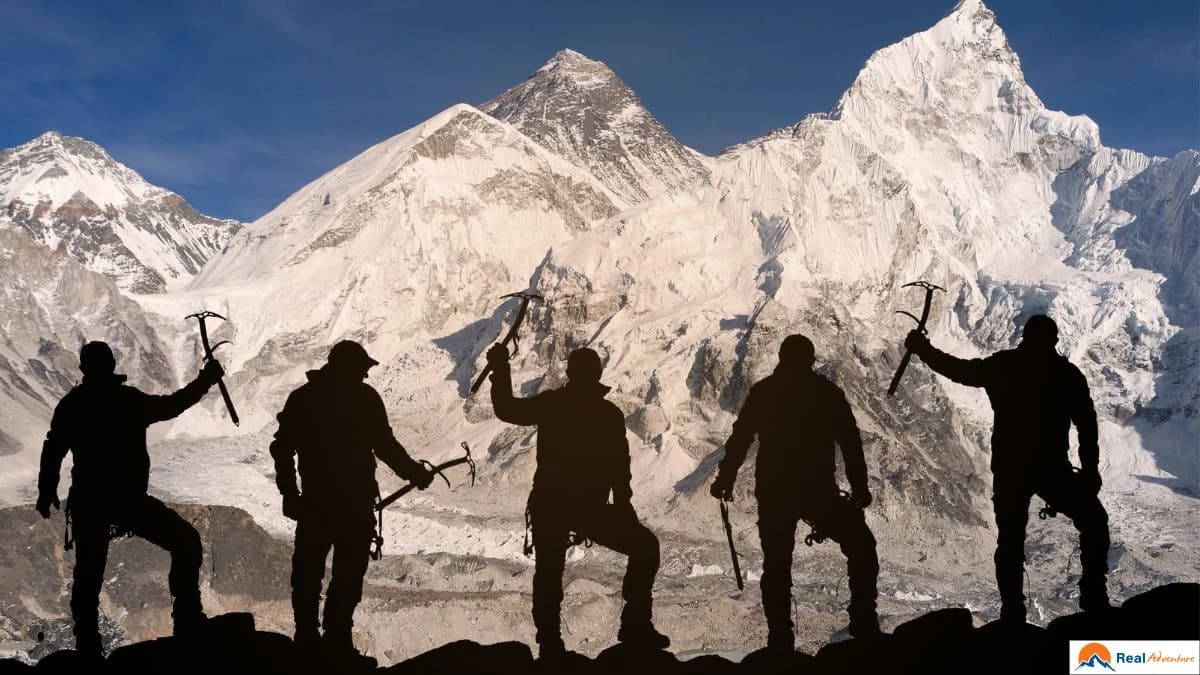
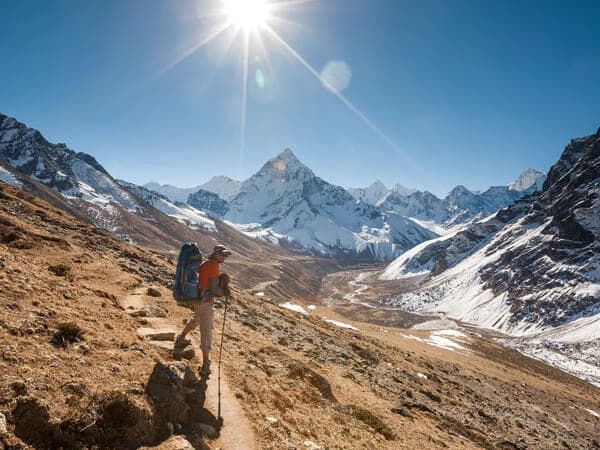

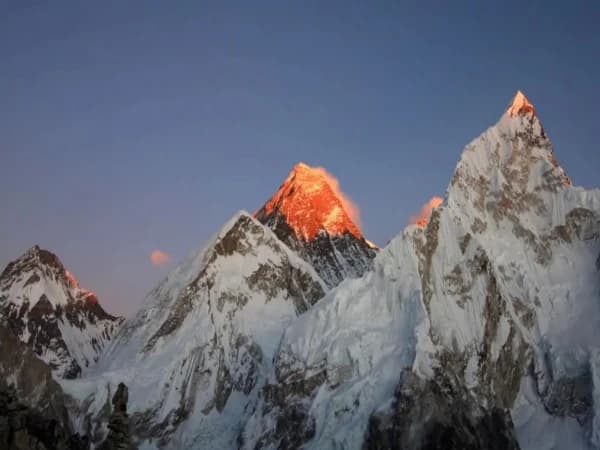
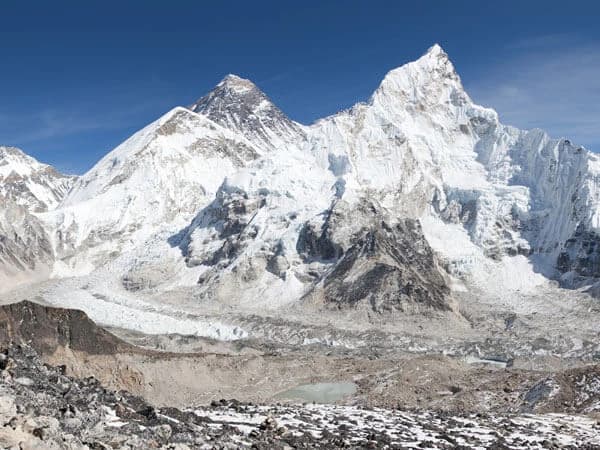

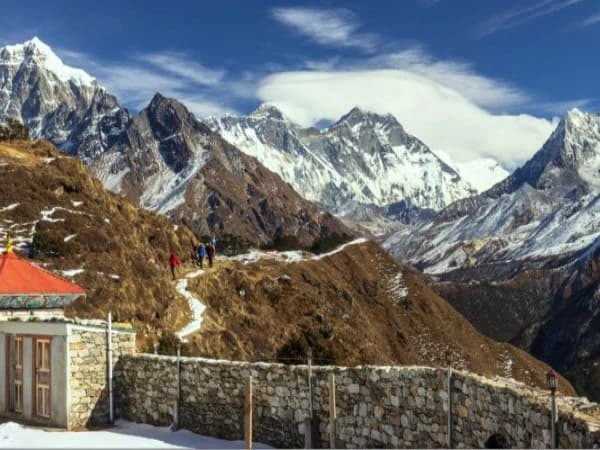
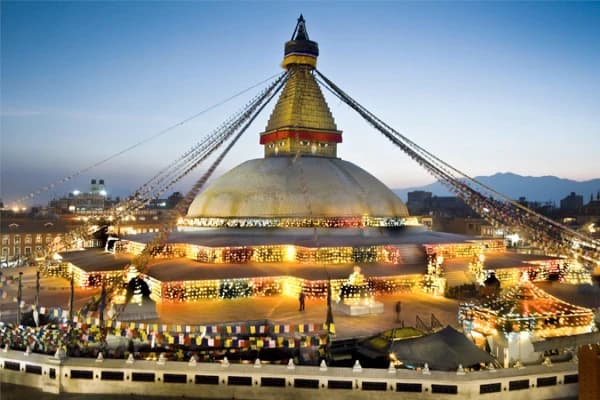
-(5).webp&w=1200&q=75&dpl=dpl_CtNAyRzUAwPdWKDCFxYk5p2VryPh)
